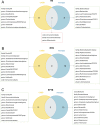Causal relationship between gut microbiota and tuberculosis: a bidirectional two-sample Mendelian randomization analysis
- PMID: 38178098
- PMCID: PMC10765819
- DOI: 10.1186/s12931-023-02652-7
Causal relationship between gut microbiota and tuberculosis: a bidirectional two-sample Mendelian randomization analysis
Abstract
Background: Growing evidence from observational studies and clinical trials suggests that the gut microbiota is associated with tuberculosis (TB). However, it is unclear whether any causal relationship exists between them and whether causality is bidirectional.
Methods: A bidirectional two-sample Mendelian randomization (MR) analysis was performed. The genome-wide association study (GWAS) summary statistics of gut microbiota were obtained from the MiBioGen consortium, while the GWAS summary statistics of TB and its specific phenotypes [respiratory tuberculosis (RTB) and extrapulmonary tuberculosis (EPTB)] were retrieved from the UK Biobank and the FinnGen consortium. And 195 bacterial taxa from phylum to genus were analyzed. Inverse variance weighted (IVW), MR-Egger regression, maximum likelihood (ML), weighted median, and weighted mode methods were applied to the MR analysis. The robustness of causal estimation was tested using the heterogeneity test, horizontal pleiotropy test, and leave-one-out method.
Results: In the UK Biobank database, we found that 11 bacterial taxa had potential causal effects on TB. Three bacterial taxa genus.Akkermansia, family.Verrucomicrobiacea, order.Verrucomicrobiales were validated in the FinnGen database. Based on the results in the FinnGen database, the present study found significant differences in the characteristics of gut microbial distribution between RTB and EPTB. Four bacterial taxa genus.LachnospiraceaeUCG010, genus.Parabacteroides, genus.RuminococcaceaeUCG011, and order.Bacillales were common traits in relation to both RTB and TB, among which order.Bacillales showed a protective effect. Additionally, family.Bacteroidacea and genus.Bacteroides were identified as common traits in relation to both EPTB and TB, positively associating with a higher risk of EPTB. In reverse MR analysis, no causal association was identified. No significant heterogeneity of instrumental variables (IVs) or horizontal pleiotropy was found.
Conclusion: Our study supports a one-way causal relationship between gut microbiota and TB, with gut microbiota having a causal effect on TB. The identification of characteristic gut microbiota provides scientific insights for the potential application of the gut microbiota as a preventive, diagnostic, and therapeutic tool for TB.
Keywords: Causal relationship; Extrapulmonary tuberculosis; Gut microbiota; Mendelian randomization; Respiratory tuberculosis; Tuberculosis.
© 2024. The Author(s).
Conflict of interest statement
The authors declare that they have no competing interests.
Figures






References
MeSH terms
Grants and funding
- 2022YFC2305001/Sub-topic of National Key Research and Development Program
- 2022YFC2305001/Sub-topic of National Key Research and Development Program
- 2022YFC2305001/Sub-topic of National Key Research and Development Program
- 2022YFC2305001/Sub-topic of National Key Research and Development Program
- 2022YFC2305001/Sub-topic of National Key Research and Development Program
- 2022YFC2305001/Sub-topic of National Key Research and Development Program
- 2022YFC2305001/Sub-topic of National Key Research and Development Program
- 2022YFC2305001/Sub-topic of National Key Research and Development Program
- 2022YFC2305001/Sub-topic of National Key Research and Development Program
- 2022YFC2305001/Sub-topic of National Key Research and Development Program
- 2022YFC2305001/Sub-topic of National Key Research and Development Program
- GuikeAD23026283/Specific Research Project of Guangxi for Research Bases and Talents
- GuikeAD23026283/Specific Research Project of Guangxi for Research Bases and Talents
- GuikeAD23026283/Specific Research Project of Guangxi for Research Bases and Talents
- GuikeAD23026283/Specific Research Project of Guangxi for Research Bases and Talents
- GuikeAD23026283/Specific Research Project of Guangxi for Research Bases and Talents
- GuikeAD23026283/Specific Research Project of Guangxi for Research Bases and Talents
- GuikeAD23026283/Specific Research Project of Guangxi for Research Bases and Talents
- GuikeAD23026283/Specific Research Project of Guangxi for Research Bases and Talents
- GuikeAD23026283/Specific Research Project of Guangxi for Research Bases and Talents
- GuikeAD23026283/Specific Research Project of Guangxi for Research Bases and Talents
- GuikeAD23026283/Specific Research Project of Guangxi for Research Bases and Talents
- 2022GXNSFBA035660/Guangxi Youth Science Foundation Project
- 2022GXNSFBA035660/Guangxi Youth Science Foundation Project
- 2022GXNSFBA035660/Guangxi Youth Science Foundation Project
- 2022GXNSFBA035660/Guangxi Youth Science Foundation Project
- 2022GXNSFBA035660/Guangxi Youth Science Foundation Project
- 2022GXNSFBA035660/Guangxi Youth Science Foundation Project
- 2022GXNSFBA035660/Guangxi Youth Science Foundation Project
- 2022GXNSFBA035660/Guangxi Youth Science Foundation Project
- 2022GXNSFBA035660/Guangxi Youth Science Foundation Project
- 2022GXNSFBA035660/Guangxi Youth Science Foundation Project
- 2022GXNSFBA035660/Guangxi Youth Science Foundation Project
- DC2300001767/Guangxi Medical University Training Program for Distinguished Young Scholars
- DC2300001767/Guangxi Medical University Training Program for Distinguished Young Scholars
- DC2300001767/Guangxi Medical University Training Program for Distinguished Young Scholars
- DC2300001767/Guangxi Medical University Training Program for Distinguished Young Scholars
- DC2300001767/Guangxi Medical University Training Program for Distinguished Young Scholars
- DC2300001767/Guangxi Medical University Training Program for Distinguished Young Scholars
- DC2300001767/Guangxi Medical University Training Program for Distinguished Young Scholars
- DC2300001767/Guangxi Medical University Training Program for Distinguished Young Scholars
- DC2300001767/Guangxi Medical University Training Program for Distinguished Young Scholars
- DC2300001767/Guangxi Medical University Training Program for Distinguished Young Scholars
- DC2300001767/Guangxi Medical University Training Program for Distinguished Young Scholars
LinkOut - more resources
Full Text Sources
Medical

